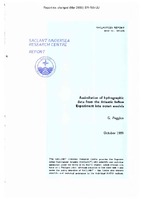| dc.contributor.author | Peggion, Germana | |
| dc.date.accessioned | 2018-10-11T14:06:47Z | |
| dc.date.available | 2018-10-11T14:06:47Z | |
| dc.date.issued | 1989/10 | |
| dc.identifier | 1935 | |
| dc.identifier.govdoc | SR-155 | |
| dc.identifier.uri | http://hdl.handle.net/20.500.12489/297 | |
| dc.description.abstract | This study represents the link between observational and numerical programs. A method for data | |
| dc.description.abstract | assimilation in dynamical analysis is presented and discussed. This approach assumes that the | |
| dc.description.abstract | observational program furnishes an adequate 'instantaneous' representation of the ocean, but the | |
| dc.description.abstract | region is lacking a large amount of historical data suitable for a valid analysis of the mesoscale variability. From processed temperature and salinity distributions, absolute geostrophic velocities are computed using the inverse method proposed earlier by the author. The model is formulated on a 3D spherical-shell coordinate system, using geostrophic, hydrostatic, and Boussinesq approximations. Within the assigned dynamical constraints, a differential equation can be derived for the bottom | |
| dc.description.abstract | pressure associated with the bottom geostrophic velocities. The results from the Atlantic Inflow Experiment are compared with climatological values from the Generalized Digital Environmental Model of the Naval Oceanographic Office. | |
| dc.format | 32 p. : ill. ; 31 fig. | |
| dc.language | English | |
| dc.publisher | NATO. SACLANTCEN | |
| dc.relation.ispartofseries | ADB141311 | |
| dc.subject | Oceanography - Mathematical models | |
| dc.subject | Atlantic Ocean | |
| dc.subject | Atlantic Inflow Experiment | |
| dc.title | Assimilation of hydrographic data from the Atlantic inflow experiment into ocean models | |
| dc.type | Scientific Report (SR) | |
